Abstract
Using ten microsatellite loci, paternity analysis has been conducted for 71 individuals of the Siberian crane (Grus leucogeranus Pallas) obtained under artificial insemination in Oka Crane Breeding Center in 2001–2014. The fathers of 39 chicks were the sires whose sperm was used for insemination directly before fertilized egg laying. Paternity of 23 fertilizations belonged to the sires whose sperm was used in the beginning or middle of insemination cycle. Nine cases of fertilization resulted from natural copulation of artificially inseminated females with their social partners. The terms of sperm storage in the female’s reproductive ducts before fertilization were 0–6 days in the case of paternity of the last sperm donor and 2–15 days in the case of competing sperm by previous donors. Genetic relatedness by microsatellite loci between breeders of the captive Siberian crane population does not prevent fertilization and does not always lead to inbreeding depression.
Similar content being viewed by others
References
Birkhead, T.R., Cryptic female choice: criteria for establishing female sperm choice, Evolution, 1998, vol. 52, no. 4, pp. 1212–1218.
Birkhead, T.R. and Pizzari, T., Postcopulatory sexual selection, Nature Rev. Genet., 2002, vol. 3, no. 4, pp. 262–273.
Evans, J.P., Zane, L., Francescato, S., and Pilastro, A., Directional postcopulatory sexual selection revealed by artificial insemination, Nature, 2003, vol. 421, no. 6921, pp. 360–363.
Foerster, K., Delhey, K., Johnsen, A., et al., Females increase offspring heterozygosity and fitness through extra-pair matings, Nature, 2003, vol. 425, no. 6959, pp. 714–717.
Hayes, M.A., Britten, H.B., and Barzen, J.A., Extra-pair fertilizations in sandhill cranes revealed using microsatellite DNA markers, Condor, 2006, vol. 108, no. 4, pp. 970–976.
Hayes, M.A., Observation of an extra-pair copulation by sandhill cranes, Wilson J. Ornith., 2007, vol. 119, no. 1, pp. 113–116.
Jones, K.L. and Nicolich, J.M.,, Artificial insemination in captive whooping cranes: results from genetic analyses, Zoo Biol., 2001, no. 20, pp. 331–342.
Kashentseva, T.A. and Belterman, R., Siberian Crane, Grus leucogeranus International Studbook, Oka State Biosphere Nature Reserve, 2014.
Lovlie, H., Gillingham, M.A.F., Worley, K., et al., Cryptic female choice favours sperm from major histocompatibility complex-dissimilar males, Proc. R. Soc. B, 2013, vol. 280, no. 1769, pp. 1–9.
Maksudov, G.Yu., Long-term sperm survival in the reproductive ducts of female vertebrates, Extended Abstract of Cand. Sci. (Biol.) Dissertation, Moscow: MGU, 1996.
Maksudov, G.Yu., Environmental aspects of the long-term sperm survival in the reproductive ducts genital tract of female cranes, in Zhuravli Evrazii (Biologiya, Ohrana, Razvedenie) (Cranes of Eurasia (Biology, Conservation, and Breeding)), 2006, no. 2, pp. 57–60.
Maksudov, G.Yu., Markina, T.A., and Panchenko, V.G., Sperm survival in the female sandhill crane, Ornitologiya, 1991, vol. 25, pp. 198–200.
Mays, H.L. and Hill, G.E., Choosing mates: good genes versus genes that are a good fit, Trends Ecol. Evol., 2004, vol. 19, no. 10, pp. 554–559.
Mays, H.L., Albrecht, T., Liu, M., and Hill, G.E., Female choice for genetic complementarity in birds: a review, Genetics, 2008, vol. 134, no. 1, pp. 147–158.
Mudrik, E.A., Kashentseva, T.A., and Politov, D.V., Genetic diversity and multilocus genotyping of Siberian crane for microsatellite loci, in Zhuravli Evrazii (Biologiya, rasprostranenie, migratsiya, upravlenie) (Cranes of Eurasia (Biology, Distribution, Migration, Management)), 2011, no. 4, pp. 81–87.
Mudrik, E.A., Kashentseva, T.A., and Politov, D.V., DNA analysis proved paternity of “husbands” in artificially bred Siberian cranes, Siberian Crane Flyway News, 2014a, no. 13, pp. 21–22.
Mudrik, E.A., Kashentseva, T.A., Gamburg, E.A., and Politov, D.V., Genetic passportization and identification of Siberian cranes (Grus leucogeranus Pallas) in captivity, Biol. Bull. (Moscow), 2014b, vol. 41, no. 3, pp. 208–215.
Peakall, R. and Smouse, P.E., GenAlEx 6.5: genetic analysis in Excel. Population genetic software for teaching and research—an update, Bioinformatics, 2012, no. 28, pp. 2537–2539.
Queller, D.C. and Goodnight, K.F., Estimating relatedness using genetic markers, Evolution, 1989, vol. 43, no. 2, pp. 258–275.
Russman, S.I., Timing insemination to maximize fertility in cranes, in Proc. Crane Workshop, Lewis, J.C., Ed., Grand Island, Nebr., 1985, pp. 398–405.
Swengel, S.R. and Tuite, M.L., Recent advances in scheduling strategies and practical techniques in crane artificial insemination, Proc. North Am. Crane Workshop, 1997, no. 7, pp. 46–55.
Tarvin, K.A., Webster, M.S., Tuttle, E.M., and Pruett-Jones, S., Genetic similarity of social mates predicts the level of extrapair paternity in splendid fairy-wrens, Anim. Behav., 2005, no. 70, pp. 945–955.
Tregenza, T. and Wedell, N., Genetic compatibility, mate choice and patterns of parentage: invited review, Mol. Ecol., 2000, vol. 9, no. 8, pp. 1013–1027.
Tregenza, T. and Wedell, N., Polyandrous females avoid costs of inbreeding, Nature, 2002, vol. 415, no. 6867, pp. 71–73.
Walsh, P.S., Metzger, D.A., and Higuchi, R., Chelex-100 as a medium for simple extraction of DNA for PCRbased typing from forensic material, BioTechniques, 1991, vol. 10, no. 4, pp. 506–513.
Zeh, J.A. and Zeh, D.W., The evolution of polyandry II: Post-copulatory defenses against genetic incompatibility, Proc. R. Soc. Lond. B, 1997, vol. 264, no. 1378, pp. 69–75.
Author information
Authors and Affiliations
Corresponding author
Additional information
Original Russian Text © E.A. Mudrik, T.A. Kashentseva, D.V. Politov, 2016, published in Ontogenez, 2016, Vol. 47, No. 3, pp. 131–137.
Rights and permissions
About this article
Cite this article
Mudrik, E.A., Kashentseva, T.A. & Politov, D.V. Long-term sperm storage in the Siberian crane (Grus leucogeranus pallas): Analysis of paternity and relatedness under artificial insemination. Russ J Dev Biol 47, 103–108 (2016). https://doi.org/10.1134/S106236041603005X
Received:
Accepted:
Published:
Issue Date:
DOI: https://doi.org/10.1134/S106236041603005X




